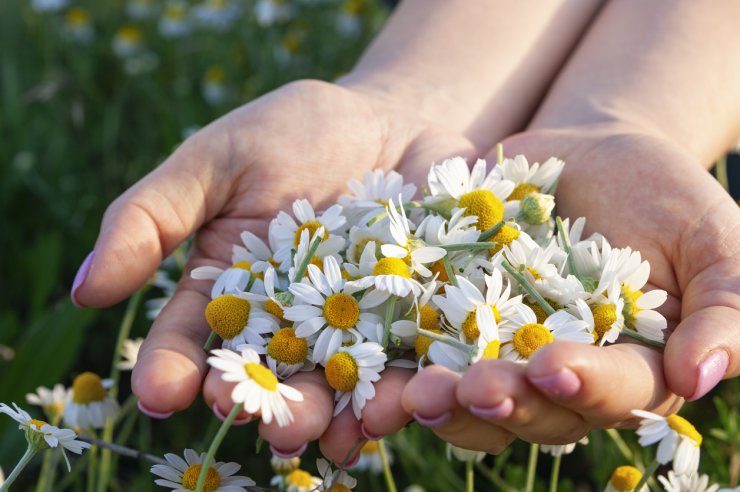
Freshly harvested chamomile blossoms.
Your chamomile harvest is ready when the flower petals are white and the centers are bright yellow. The best times to harvest are early in the morning after the dew has evaporated from the flowers, or late in the evening—this is when the oils are most concentrated in the flowers. If it has rained recently, wait a day or two; chamomile is good at retaining moisture, and you don’t want too much moisture when you’re picking the flowers to dry them.
Harvesting chamomile is a labor of love. One. Flower. At. A. Time. OK, it may not be quite that slow, depending on your picking technique. You can pick the flowers one at a time. You can also use a specialized tool called a chamomile rake, but it’s expensive and probably won’t save you that much time. You can spread your fingers and comb through the blossoms, tossing them into your basket as you go. If you really like the chamomile rake idea, there are some DIY plans available online.
If your inner child is screaming to come out, you can pinch the base of the blossom with your thumb and forefinger and just pop the blossom off the stem. It’s a lot like dead-heading (and also a lot like kids sometimes do with dandelions, popping their heads off).
As you pick your blossoms, collect them in a container that breathes, like a basket or even a paper bag. Now, you will certainly wind up with part of the flower stem along with the flower. After you’ve finished harvesting, take the time to snip the stem parts off the blossoms; the stem can add a bitter edge to your tea.
Once you’ve harvested a bunch of your flowers, you’ll notice that you have a lot of stems left over. Some will be in your garden bed or container; some will still be standing. Many of the standing stems will have buds forming lower down; those are future flowers (more tea for you!). As for the stem pieces on the ground—just leave them there. They make a nice mulch, and they’ll decompose quickly and add some nutrients back into the soil.
What’s your favorite way to harvest your chamomile? Do you prefer the hand-combing method, or do you use a chamomile rake? If you harvest the flowers one at a time, do you pop the blossoms off their stems or snip them with scissors? Let us know your favorite way to gather your chamomile harvest.


 Previous
Previous

